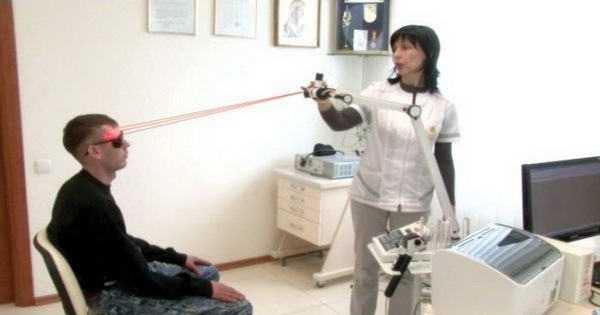Paranoia
 Paranoia is a mental disorder that causes an individual to feel unreasonably afraid. Such diseases can not be attributed fully to pathologies, paranoia has the ability to manifest itself as a symptom of some pathology and is a small fraction, part of the disease, for example, schizophrenia. And if paranoia is the only symptom, then it is inherent in a healthy, so-called, paranoid, individual with a radical fear. The individual will experience and constantly assume the worst, worry and not fall behind the others. In the social environment of almost everyone there is such a person. Such people are more inclined to develop obsessions because of their innate paranoia, through the prism of which they contemplate the environment.
Paranoia is a mental disorder that causes an individual to feel unreasonably afraid. Such diseases can not be attributed fully to pathologies, paranoia has the ability to manifest itself as a symptom of some pathology and is a small fraction, part of the disease, for example, schizophrenia. And if paranoia is the only symptom, then it is inherent in a healthy, so-called, paranoid, individual with a radical fear. The individual will experience and constantly assume the worst, worry and not fall behind the others. In the social environment of almost everyone there is such a person. Such people are more inclined to develop obsessions because of their innate paranoia, through the prism of which they contemplate the environment.
What is paranoia?
Paranoia has different interpretations, but they all come from the Greek, according to one of them, paranoia translates as thinking, in another way, "pair" means about, and "noos" is thoughts or the mind, and therefore circumlocution literally comes out. On the one hand, the more common definition of paranoia is a disorder of the psychic sphere that keeps pace or is the most suspicious, inclined to reveal evil intent in everything. This is what we mean by talking about the individual paranoid. It does not mean mental illness as such, just a personality feature. Such individuals are suspicious, they suspect everyone of every little thing, but they do not happen by chance.
But in fact, paranoia has another great value that was once taken into account in psychiatry. For the first time this pathology was indicated by the well-known psychiatrist Kalbaum, who observes many such cases in individuals of advanced age. This discovery took place in the 19th century, but this diagnosis is not being exhibited now. And he called paranoia nonsense and all delusional disorders, he marked their danger to the environment and the negative impact of having one on the patient himself. Later Kraepelin practiced paranoia and indicated that only a small percentage of such symptoms are actually paranoia. Back in the ICD 9, this pathology was a separate rare type of psychosis. Now ICD-10 has an extensive base, which allows to reliably diagnose, based on the syndromic and nosological principle. And yet it is worth noting that paranoia will doubtfully disappear from the general dictionary use due to the identity of the expression, allowing to emphasize the personality of the individual.
Speaking about the epidemiology of the disease, it is important to note that the very paranoid disorder, as a second definition of delusional ideas, is noted in only 0.5% of patients, and in the direction of reducing the coefficient. But the paranoid personality traits in a more philistine understanding are inherent in a much larger number of individuals. Strangely enough, according to social studies, this group of pathologies and this type of personal behavior are more likely to men. Paranoia among men, taking the entire population, is about 13%, which exceeds the female contingent. Paranoia in women approximately meets about 6% in the population.
Causes of paranoia
Paranoia is formed according to different principles and basically can have completely different diseases, which significantly affects both the symptomatology and the safety of the individual. It develops due to neurotransmitter disorders, in particular with dopamine disturbances.
If this is paranoia, as a type of personal behavior, then it is formed from a child's age due to some educational features. Any individual develops a certain type of response to stressors, which is difficult to change. It is he who determines the type of reaction to everything that is happening new and incomprehensible.
A vital role in the formation of paranoia is played by life situations, if an individual of a paranoid type, once asserting a personal right for himself in a situation where he is paranoid, he will be even more convinced of a conspiracy around himself and will even more pathologically interpret everything. Often an autoaggression, that is, directed into itself, the individual throws on others, not noticing this due to internal protective mechanisms. It can be different defense mechanisms, for example, projection or negation, the individual himself does it unconsciously and very much suffers from this. If a person has developed into a paranoid type, then it is difficult to return and deterioration occurs with age. Often an increasing number of individuals are involved in this process. In general, such an individual to all is hostile.
Paranoia in children - this is usually a consequence of incorrect education, leading to unnecessary, harmful to the child fears.
Paranoia can enter the structure of schizophrenia, which has a few other aspects of manifestation, but is very dangerous for the person himself and for others. Not in all forms of paranoia schizophrenia is a characteristic syndrome, this syndrome is still most paranoid of the same name.
Paranoia in women is often formed under the influence of the endocrine system, especially in menopausal age. This pathology is considered an involution paranoid.
Paranoia in men( less often in women) is often provoked by alcohol intoxication. Less often it can be drugs or any toxic substances. But with prolonged use of alcohol undoubtedly formed an alcoholic paranoid. Many diseases are capable of giving symptoms like paranoia or paranoid characteristics, in particular, these are senile dement diseases, if psychotic symptoms are mixed with them.
Paranoid can provoke Alzheimer's disease, Huntington's chorea. Parkinsonism and even vascular diseases can give a syndrome paranoia. Paranoia can be a hidden characteristic of a personality manifesting itself in moments of desperation, with the death of a loved one, a divorce process, or tremendous stress. Paranoia can be formed as a neurotic process even in healthy people in critical times, for example, with constant moving, in wartime, with long train riding. Blind and deaf people sometimes have a feeling that everyone is discussing them and making reservations. Also, paranoia can amaze the "near" person living with a mentally unhealthy person who already has paranoia, in the manner of induced delirium.
Symptoms and signs of paranoia
Paranoia is a condition that has origins from a variety of pathologies, and accordingly they will develop symptomatology. That's why paranoia is different. If this is a character characteristic of the personality, then its ideas will be of the type of overvalued, that is, the individual will not be completely absorbed by it. From these ideas, it is possible to distract him, and even to convince some of them. At the same time in all other aspects the individual functions completely without failures and does not show any strangeness. That is, without touching any painful conspiratorial themes, it is possible to work absolutely seamlessly and exist with the individual. But such individuals with age have the risk of becoming simply unbearable. Paranoia in men with age can often manifest itself in ridiculous jealousy.
If this is a manifestation of schizophrenia, then paranoid ideas will be formed due to hallucinations and their composition will vary depending on the kind of hallucinations. In this case, the paranoid syndrome has well-defined characteristics. First, the syndrome of openness of thoughts, direct or reverse, in which the individual is convinced that he is able to read the thoughts of others or, conversely, his thoughts are read. In this case, the individual feels that it is influenced by physical equipment, for example, bake with rays or various mechanisms, put ideas into his head. In addition, with such a syndrome, automatisms are always inherent, they can be motor, ideator and sensory, when the individual realizes that his thoughts, feelings or actions are controlled. It can also be the idea of harm when an individual complains of a material or moral damage. Here, the speech-motor hallucinations of Segla can appear, as a subset of motor automatisms. In this case, the individual puts out his tongue, makes strange movements with his mouth and speaks his own non-existent language. If paranoia is manifested simply in the context of delusional disorder, then delusion is monotimatic and crystallizes for a long time.
Paranoia in children is less pathological, it is more like a child's fears. The child will be afraid to sleep alone, will argue that there is something under the bed. Children in the whole person are very suggestive, so any shadow can seem to them "evil babeyka", which, perhaps, will lead to timidity at night.
Paranoia in women is often manifested in the idea of loss, that someone is causing material harm to them. Also, women can often engage in litigations and querulences. Paranoia in women also often pours into love nonsense, then a woman pursues a man, claiming that he is in love with her.
Paranoia, like a crazy idea, is formed in several stages. At first this is just a suspicious mood, flowing into a delirious interpretation of the situation, but the individual can not yet tell what is wrong, he just feels it. Later, nonsense crystallizes and manifests itself in the form of a delusional monotematic idea, as a rule of persecution. After the hallucinatory-paranoid syndrome, described above, already appears, when the nonsense changes depending on hallucinations. In the future, he goes to the paraphrenic stage, which ends with a specific puzzle.
Types of paranoia
It makes sense to identify the types of delusions, referring them all to paranoia, if we talk about it, as a characteristic of the Kalbaum. To delusional ideas of the peach series, which are just the ideas of persecution, that is, paranoid, belong to a very large group. These are the ideas of the relationship, when the patient starts to note that he is badly, prejudiced, does not appreciate his activity, wants him evil and besides everything around him. All around the enemy, bringing a continuous negative, dangerous for communication. Influence ideas have several subspecies, the effect can be physical, while electromagnetic waves, ultraviolet or ultrasound, radiation or even irradiation are involved. With psychic influence, the person is confident that her thoughts are influenced by special devices, which leads to irreparable actions in his head. Ideas of damage, moral, when the person is sure that she is insulted in some unprecedented way or material, when the damage is revealed by the individual in his things. Dysmorphomanic ideas also apply to paranoia. They often show paranoia in children, but the child is sure that everything is not right with his body and it goes to the point of absurdity: the head does not go through the door, one foot is twice the size of the other, and so on.
Paranoia in men often in its structure contains zealous ideas, moreover, very dangerous and absurd. Such jealous people say that the wife is betraying them through the wall and the like. The most common are persecution ideas, in which a person claims to be pursued by enemies, specials. Service, fans, in fact, anyone, even an ex-wife. But all these statements are absurd, you can listen for hours why this character needed a special. Services. The idea of poisoning is also referred to as peach, while the individual does not at all eat at home, buying crackers and seafood so as not to be poisoned. Induced delirium is a completely separate species that appears, as if cast by an individual with an unhealthy psyche to someone from his environment. Usually the character, delusional delirium has some intellectual decline, it also happens in children. In this case, the character begins to say that his relative is really being persecuted and even trying to kill. Conformal delirium has very individual characteristics, an individual, for example, denotes that he is being poisoned, but when trying to find out from what he took it, he will throw the birth of an idea to someone from others, for example: "this neighbor in the ward said to meWant to poison. "To delusional ideas, less characteristic of paranoia, but still require mentioning include hypochondria, nihilism, self-blame, sinfulness, self-abasement, as well as ideas of greatness, wealth, reformism, invention and special origin.
Treatment of paranoia
An integrated approach is important for the treatment of paranoia. Paranoia in men with alcohol complications is stopped by withdrawal from the state of dependence, only then the disease slowly goes away. Paranoia in women in menopause requires some hormonal adjustments and in some cases daily antipsychotics, such as Eglonila. Paranoia in children is disactualized with the help of a gentle normal day regimen, proper training with a child, the work of a psychologist and art therapy, and in no case should you frighten a child.
In severe cases, if the paranoia has a clear psychotic nature, that is, lies in the structure of schizophrenia or delusional disorder, it should be treated appropriately. Neuroleptics with a sedative effect on excitation are used: Aminazine, Tizercin, Truksal, which has an anxiolytic effect. Since crazy ideas are a productive syndrome, neuroleptics with the corresponding effect are used to remove psycho products, namely Haloperidol, Triftazine, Mezheptil. Atypical antipsychotics can be an excellent remedy for maintaining a normal state: Azaleptil, Risperidone, Rispaksol, Rispoleptus Konsta, Querotone, Quetepin, Solian, Soleron, Solex, Sardinol, Serdolect. In the case of schizophrenia, in particular the presence of a defect, neuroleptic stimulants are applicable: Fluanxol, Sonapax, Eglonyl, Sulpiride, and Frenolone. Palipiridone, Haloperidol decoate, Monite Depot, Clopixol Depot, Arap, Imap are also used.
If it is a paranoid of induced etiology or any other nervous origin, then tranquilizers, like benzodiazepine series, and other groups are used. To them belong: Sibazon, Relium, Phenazepam, Tazepam, Seduxen, Reladorm, Noofen, Bifren, Adaptol, Afobazol, Gidazepam, Xanax. This destroys the biological part of the barrier. For the needs of the same apply psychotherapy and social adaptation, which remove the psychological and social parts of nerve barriers.



